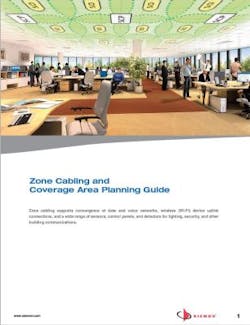Planning guide for cabling highly automated intelligent buildings
Siemon has released a new Zone Cabling and Coverage Area Planning Guide, which the company explained was developed to assist infrastructure designers and architects ensure flexible zone cabling designs that provide significant benefits within intelligent buildings.
When announcing the guide’s available, Siemon said, “By 2020, it’s estimated that there will be 26 times as many connected devices as connected people. The growing adoption of Internet of Things (IoT) will be optimally supported by a cabling design where low-voltage building, network and security systems are converged on a single IP network infrastructure and powered by advanced Power over Ethernet (PoE) technology. Ideally suited for these converged infrastructures, zone cabling consists of horizontal cables run from telecommunications rooms to intermediate connection points housed in zone enclosures typically placed in the ceiling space. Cables from zone unit enclosures connect directly to building devices such as sensors, wireless access points, cameras and digital signage or to outlets serving any such device. Combining these connections within zone enclosures supports rapid, less-disruptive changes and reorganization of work areas while simplifying deployment of new devices and applications.” (See illustration at bottom of page.)
The Zone Cabling and Coverage Area Planning Guide explains the various patterns that designers and architects can use for effective arrangements of coverage areas and their associated zone enclosures. The guide also highlights best practices for optimizing device density, scalability, and flexibility, and it covers considerations for selecting cable media and complying with industry standards.
“Deploying a zone cabling approach that facilitates building device connections within zone enclosures saves significant cost for automated buildings, where a variety of low-voltage systems are converging on a single unified physical infrastructure,” said Valerie Maguire, global sales engineer for Siemon. “It’s important for those designing these converged infrastructures to realize the benefit of this highly economical and functional standards-based design and to understand how best to deploy it.”
The company concluded, “As designers and architects strive to leverage IoT and deploy a converged cabling approach that allows connected systems to collect and analyze data for new levels of building intelligence, Siemon’s Zone Cabling and Coverage Area Planning Guide will serve as a critical reference to ensuring that cabling infrastructures are optimized to support these new trends in building design.”
You can download Siemon’s Zone Cabling and Coverage Area Planning Guide here.
